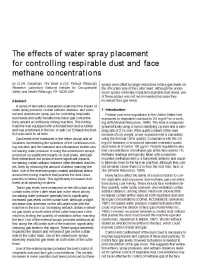Mining Publication: The Effects of Water Spray Placement for Controlling Respirable Dust and Face Methane Concentrations
Original creation date: April 2006
Authors: GV Goodman, TW Beck, DE Pollock
NIOSHTIC2 Number: 20031466
J Mine Vent Soc S Afr 2006 Apr-Jun; 59(2):56-63
A series of laboratory evaluations examined the impact of water spray pressure, curtain setback distance, and external and underboom spray use for controlling respirable dust levels and sulfur hexafluoride tracer gas concentrations around a continuous mining machine. This mining machine was equipped with a flooded-bed dust scrubber and was positioned in the box or slab cut. Exhaust line brattice was used for all tests. Dust levels were measured in the return airway and at locations representing the operators of the continuous mining machine and the standard and off-standard shuttle cars. Increasing water pressure or using the underboom sprays produced no significant impacts on dust levels, although their interactions did produce some significant impacts. Increasing curtain setback distance often elevated dust levels, likely by reducing the amount of airflow reaching the face. Use of the external sprays created additional airflow around the mining machine that pushed the dust cloud past the scrubber inlets. This significantly increased dust levels at all sampling locations. Tracer gas levels were measured on the off-curtain and curtain sides of the cutter head and in the return airway. Increasing water pressure generally led to significantly increased gas levels on the curtain side, although a slight decrease was observed on the off-curtain side with the machine in the box cut. Increasing setback distance elevated gas levels on both sides of the cutter head and in the return by limiting the quantity of ventilation airflow reaching the face. Use of the external sprays provided additional airflow along the off-curtain side of the machine, significantly reducing gas levels in this region. These sprays adversely impacted the dilution and removal of gas on the curtain side of the cutter head. Use of the underboom sprays adversely impacted gas levels on both sides of the cutter head. Use of the external sprays provided the best control of respirable dust and face gas concentrations. The smaller increases in miner operator dust levels produced by these sprays were offset by larger reductions in face gas levels on the off-curtain side of the cutter head. Although the underboom sprays minimally impacted respirable dust levels, use of these sprays was not recommended because they increased face gas levels.

NIOSHTIC2 Number: 20031466
J Mine Vent Soc S Afr 2006 Apr-Jun; 59(2):56-63
- Controlling Respirable Dust in Underground Coal Mines in the United States
- Developing and Improving Respirable Dust Controls in Coal Mines
- Dust Control Practices for Underground Coal Mining
- Field Evaluation of Air-blocking Shelf for Dust Control on Blasthole Drills
- Guidelines for the Control and Monitoring of Methane Gas on Continuous Mining Operations
- Impact of Control Parameters on Shearer-Generated Dust Levels
- Improved Dust Control Methods for Longwall Mining
- Laboratory Evaluation of Shield Dust Entrainment in High-Velocity Airstreams
- Laboratory Testing To Quantify Dust Entrainment During Shield Advance
- Performance of a Light Scattering Dust Monitor at Various Air Velocities: Results of Sampling in the Active Versus the Passive Mode